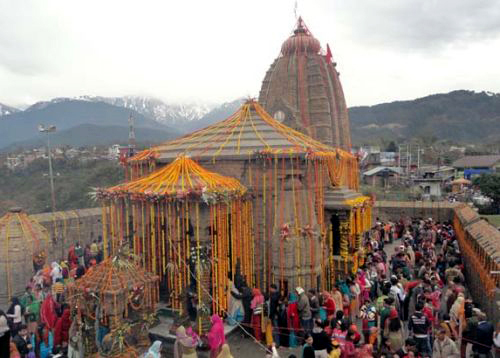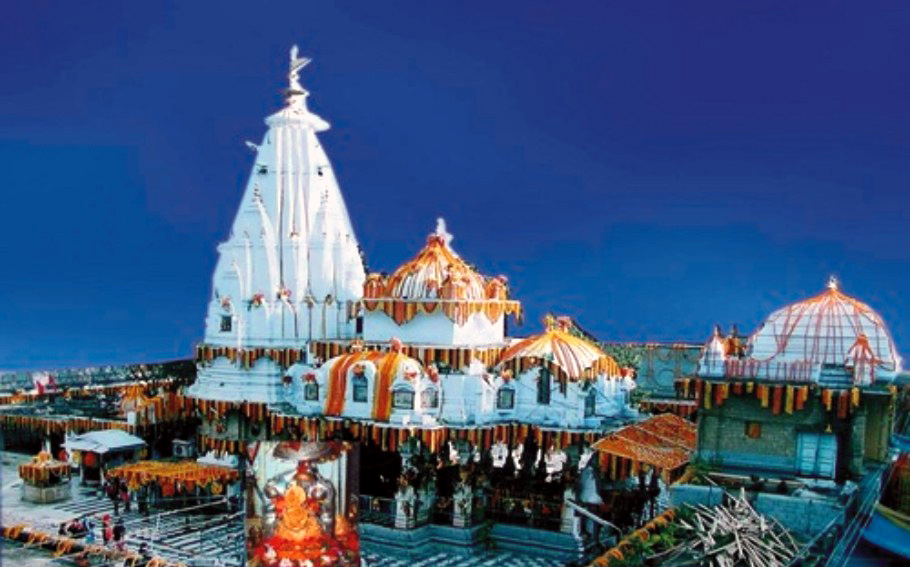Temples of Kangra
TEMPLES OF KANGRA
Kangra is also known as "Dev Bhumi" (the valley of Gods) & there are almost 3000 big and small temples in the Kangra valley.

Ashapuri Temple
Situated in the forests of Rajgir. This fortified temple is at a height of 5000 feet. In history it is believed that when the Muslims attacked the temple - the temple was defended by wasps (large hornets). These wasps can still seen be seen in the dome of the temple. This fortress was also used as a treasure house for the Katoch Rajas.
The other temples worth visiting are:
- Bagla Mukhi (famous for warding off evil), Chinitpurni
- The Narbdeshwar (Kangra miniature painted temple)
- The painted temple of Sansar Chandreshwar, which has the largest Ashat Dhatu (made of the combination of eight precious metals) idols in India, Shiv Parvati and Nandi combined weighing over three tones - this temple is also one of the only Shiv Parvati temple which has idols instead of a Lingam - it is believed that the downfalls of Maharaja Sansar Chandra started after he constructed this temple (two reasons).
- That he made the idols of Shiv and Parvati in his own face (he became a megalomaniac) & for this blasphemy his seven generations were cursed by the priests.
- Maharaja Ranjit Singh sent a large cursed diamond though a Merchant to the court of Maharaja Sansar Chandra (this diamond was said to bring downfall and disaster on its owner) - Maharaja Sansar Chandra bought the diamond and put it on the idol of Shiva as the third eye - in the earthquake of A.D. 1905, this diamond was lost forever.
There are many other temples i.e. Murli Manohar - Thakur Dwara - Hanuman Mandir, Kunjdwar studded in across the valley. All of which are ancient a nd important in their own right.

Baijnath Temple
A 9th century A.D. temple dedicated to Lord Shiva - it is the oldest Jyotirling temple in India.
The inscriptions tell us that a Shivalinga known as Vaidyanatha already existed on the spot but was without a proper house so the present temple and a porch in its front was constructed. British Archaeologist Alexander Cunningham noticed an inscription of 1786 in the temple referring to its renovations by Maharaja Sansar Chandra. An inscription on the wooden doors of the sanctum of the temple provides the date as samvat 1840 (AD 1783) that is very near to Cunningham's date. The devastating earthquake that shook the entire region of Kangra on 4 th April 1905 also caused damage to the shrine, which has been reported by J. Ph. Vogel and has since been repaired.

Masroor Temple
Also a 9th century rock cut (like Ajanta and Ellora) temple dedicated to Lord Ram.
The main shrine of the temple complex contains three stone images of Ram, Lakshman and Sita. The temple complex is located on a hill and also has a large rectangular pond which remains filled with water throughout the year. In the center of the complex stands the principal and most elaborately carved shrine - the Thakurdwara. It enshrines black stone images of Ram, Lakshman and Sita facing east.
The entire theme of the temple carvings revolve around the festivity and coronation of Lord Shiva who is the center of the Hindu pantheon. The temple complex is believed to have been built by an ardent devotee of Lord Shiva. Locals believe that the Pandavas built the Masroor Rock Temple during their period of exile.

Bathu Temple
Seven kilometers from Jawali, a small town in Kangra, there stands a cluster of antique, unique, tall temples which remain dipped in water for eight months: but stand exposed only during March to June. This place, commonly known as "Bathu ki Larhi" (a string of Bathu stone-structures) enjoys the unique distinction of being a popular tourist spot.
Bathu ki Larhi is a cluster of eight temples covering a vast area which used to have strong protection walls which are now falling and crumbling in the strong current of water.
In spite of the fact that for the last 30 years this cluster of temples remains dipped in the water for eight months every year yet their stone structure has the same natural color and beauty as it used to have when they were actually constructed. The stone images set on both sides of this gate, one image being of Mother Kali and the other of Lord Ganesha.
The broken Images of Lord Vishnu and Sheshnaag, the antique artistic ladders with images of Hindu gods inside the temple domes, amply prove how the Hindu architecture was simply at its peak. The chisel and stone work in Bathu Temple is superb.

Bhagsunag Temple
A Shiv mandir in Dharamsala was built about 5100 years ago, in this temple existed the Dharamshila from which Dharamsala got its name (Dharamsala also has the oldest church in North India - St John's in the Wilderness).

Chamunda Temple
The original Chamunda temple is situated at a height of 9000 feet in the fort of Chandra Bhan ka kila - but the temple which has gained fame is the relatively new (500 years old) and built in a straight line from the original, lower down in the valley. This site is believed to be the site where the demons Chand and Mund were killed by the goddess.
Further information on the temple of Himachal can be found in the book - Temples of Himachal.






